
In the summer of 1902, US Geological Survey and UC Berkeley paleontology crews had a chance meeting in the field near Redding. Along with Merriam, the Berkeley crew included preparator Eustace Furlong, as well as museum benefactress Annie Alexander and her traveling companion, Katherine Jones. Jones’ diary recorded Alexander’s encounter with Joseph Diller of the US Geological Survey while washing her hair in a stream. Diller asked “all sorts of leading questions as to the plans of our party and in fact knew our movements as well as we did.” Alexander “gave as evasive answers as possible”1, not wanting Diller to co-opt their discoveries. Diller spent his career in the Pacific Northwest, and although not a paleontologist, he collected hundreds of fossils for the US Geological Survey. Despite the suspicion surrounding their initial meeting, Diller later referred Merriam to exposures of the Hosselkus Limestone in Cow Creek, where in 1910, Merriam and his crew discovered the skull and partial skeleton of the ichthyosaur, Shastasaurus.

Working closely with the USGS and associated UCMP collections, it is clear that UCMP and US Geological Survey staff visited many of the same places. I enjoyed reading this confirmation of such encounters. It seems fitting that the fossils collected by these two storied institutions are now reunited in the UC Museum of Paleontology.
1 Hilton, R.P. 2003. Dinosaurs and other Mesozoic Reptiles from California. University of California Press. 356 pp.
2 Sander, P.M., X. Chen, L. Cheng, and X. Wang. Short-snouted toothless ichthyosaur from China suggests Late Triassic diversification of suction feeding ichthyosaurs. PLoS ONE 6(5):e19480.